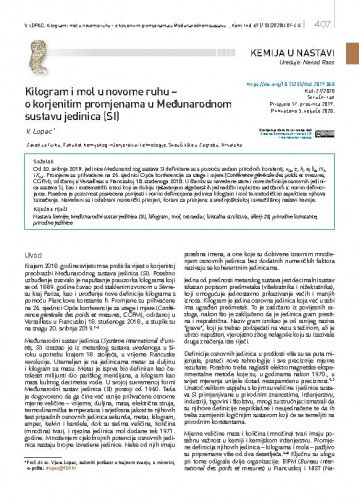Od 20. svibnja 2019. jedinice Međunarodnog sustava SI definirane su s pomoću sedam prirodnih konstanti, νCs, c, h, e, kB, NA i Kcd. Promjene su prihvaćene na 26. sjednici Opće konferencije za utege i mjere (Conférence générale des poids et mesures, CGPM), održanoj u Versaillesu u Francuskoj 18. studenoga 2018. U članku su navedene stare i nove definicije osnovnih jedinica sustava SI, kao i matematički izrazi koji se dobiju rješavanjem algebarskih jednadžbi implicitno sadržanih u novim definicijama. Posebna je pozornost posvećena povijesti i novim definicijama jedinica kilogram i mol te metodičkim aspektima njihova tumačenja. Navedeni su i odabrani numerički primjeri, korisni za primjenu u srednjoškolskoj i sveučilišnoj nastavi kemije.; At the end of the year 2018, news of a radical transformation of the International System of Units (SI) spread worldwide. Particular excitement was caused by the abandonment of the 140-year-old prototype of kilogram, the base SI unit of mass, stored under the glass bell in Sèvres near Paris, France, and by the introduction of a new definition of kilogram using the quantum-mechanical Planck constant h. The changes were accepted at the 26th session of the General Conference on Weights and Measures (CGPM) held in Versailles, France, on November 18, 2018, and entered into force on May 20, 2019. In the new definitions the SI units are derived by means of seven natural constants, νCs, c, h, e, kB, NA, and Kcd. The article presents the old and the new definitions of the seven base units of the SI system together with the mathematical expressions obtained by solving algebraic equations implicitly contained in the new definitions. The newly defined set of natural units for the base and derived quantities is discussed. The properties and the history of units kilogram and mole as well as the educational aspects of their interpretation are given special attention. Some selected numerical examples are proposed for use in the high school and university chemistry classes.
Sažetak

 Kemija u industriji : 69,7/8 (2020) / glavni i odgovorni urednik Nenad Bolf.
Kemija u industriji : 69,7/8 (2020) / glavni i odgovorni urednik Nenad Bolf.